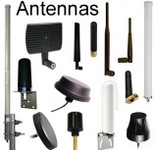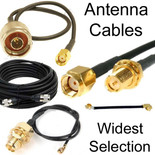RG59 Coax for BNC Cables: Best for CCTV: 75 Ohm

RG 59 cable assemblies with BNC connector
Key applications of this cable include:
- Closed Circuit Television (CCTV): RG-59 cable has demonstrable performance for analog video and is a cable of choice for connecting CCTV systems, which routinely have an impedance of 75 Ohms. It is weather-resistant and durable and is often swapped in for the fixed length, pre-packaged cable supplied with the video equipment. Its small diameter makes it easy to work with and as it is cost-effective, lengths can be cut to size for custom cable assemblies. Patch or jumper cables with BNC connectors can relay video signals between a security camera and a monitor.
- Cable television: RG 59 was until recently the cable of choice for CATV connectivity and is often found installed in many properties. However, it cannot deliver the performance required for modern, digital cable TV.
- Satellite TV: RG 59 is occasionally used for short-runs of cabling for satellite TV. The preferred cable is RG 6 which has much lower signal attenuation rates.
RG 59 Siamese cable combine RG59 coax and paired 18-gauge power wires in a single plastic jacket for added convenience in installing CCTV. It is a durable cable and saves on the time and cost of installing power and video transmission cables separately.
Both RG 59 and the BNC connector are widely used for low bandwidth and low-frequency applications including baseband and broadcast frequency video, usually over shorter distances to minimize signal attenuation. The shielding of RG 59 was originally designed for low frequency (under 50 MHz) signaling, with a drastic diminishment in performance above 1GHz.
RG 179 is a key alternative to RG 59 cable:
RG 179 is also 75 Ohms impedance but is a thinner, single shielded cable with a 7-stranded center conductor and an overall diameter of 2.8 millimeters (0.11 inches). It is far more flexible with a bend radius of 10.16 millimeters (0.4 inches). This makes it ideal for routing and installation in compact spaces. RG 179 patch cables have a frequency range of up to 3 GHz but higher attenuation rates than RG 59. At 1000 MHz the attenuation of RG 179 is 30 dB per foot rather than 12.68 dB per foot with RG 59.
50 Ohm vs 75 Ohm:
The main difference between 50 Ohm and 75 Ohm cable is the lowered resistance to the flow of electrical current supported by 50 Ohm cable. This feature impacts the power handling and overall performance of the cable with 50 Ohm cables being able to support higher frequencies than their 75 Ohm counterparts. 50 Ohm coax is therefore preferred for antenna cables for digital wireless connectivity and wireless data transfer.
However, the widespread existence of 75 Ohm coax in homes and offices as a legacy of audiovisual use means that it is still in demand, especially for shorter cable runs where better performance can be assured.
RG 59 is a type of coaxial cable with a >characteristic impedance of 75 Ohm. RG stands for Radio Guide - a legacy designation that has been retained since the 1940s and the cable number is not directly associated with the cable diameter or the military specifications that it was originally associated with. The materials used to fabricate the cable may vary slightly between manufacturers, but RG 59 usually has an overall diameter of 6.15mm.
Physical characteristics of RG 59

RG 59 is comprised of:
- A solid inner conductor that is 0.22 inches (0.56 millimeters) in diameter and made from copper-clad steel (CCS).
- A solid polyethylene (PE) or gas injected foam fluorinated ethylene propylene (FEP) dielectric of 0.146 inches (3.71 millimeters).
- A single outer shielding layer of tinned copper braid with a diameter of 0.165 inches (4.19mm). Coverage can range between 60 and 90 percent depending on the manufacturer.
- A black PVC jacket outer layer of 0.242 inches (6.15 millimeters).
Versions of this cable can vary in flexibility but the bend radius of RG 59 is typically 2 inches (50 millimeters) unless otherwise specified. It is suitable for both indoor and outdoor use with an operating temperature range of -25 to +70 degrees Celsius (-13 to 158 degrees Fahrenheit).
Electrical characteristics of RG 59
- Impedance: 75 Ohm
- Frequency Range: DC to 1 GHz
- Capacitance: 20.4 pF/ft / 66.93 pF/m
- Velocity of Propagation (Vp): 66 percent
- Operating Voltage: 2300 Volts max.
- Attenuation of RG 59
- At 100 MHz the attenuation is 3.81 dB per 100 foot
- At 200 MHz the attenuation is 5.37 dB per 100 foot
- At 550 MHz the attenuation is 9.18 dB per 100 foot
- At 800 MHz the attenuation is 11.21 dB per 100 foot
- At 1000 MHz the attenuation is 12.68 dB per 100 foot
The BNC connector
BNC stands for Bayonet Neil-Concelman and is a miniature connector for coaxial cable and is available in 50 Ohm and 75 Ohm versions. It is named after its creators, Paul Neil and Carl Concelman who developed the connector as a quick connect/disconnect radio frequency connector in the late 1940s. Its distinctive characteristic is its two-stud bayonet coupling that is a type of screw-snap connection that offers fast coupling and decoupling while supporting microwave frequencies. It is designed for frequent mating and is rated for at least 500 mating cycles.
Physical features of the BNC connector
The male BNC connector has an overall diameter of 0.570 inches (0.145 millimeters). It is typically made of brass with a nickel finish. It is larger than the female connector and carries the bayonet lock into which the female twin lugs are inserted and secured with a quarter turn. The male connector is a conducting pin made from gold or silver-plated brass. The pin is surrounded by a Teflon or Delrin insulator The female conductor is also made from nickel-plated machined brass with two lugs on its outer body. The female center receptacle is made from phosphor bronze with a PTFE dielectric. There may be a slight difference in dimensions between the 50 and 75 Ohm BNC connectors with the 75 Ohm connector having less dielectric material.
Electrical specifications of the 75 Ohm BNC connector
- The frequency range of the 75 Ohm BNC connector is DC up to a maximum of 2 GHz.
- Its working voltage is 500 Volts.
- The Voltage Standing Wave Ratio (VSWR) at 1 GHz is 1.05.
The BNC connector can be used for twist-on, crimp-on, and compression assembly with RG 59 cable. RG 59 coax jumper cables or RG 59 patch cables can be purchased pre-assembled.
Posted by George Hardesty on 8th Nov 2023

























